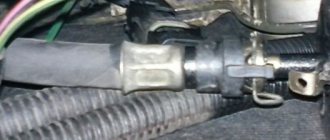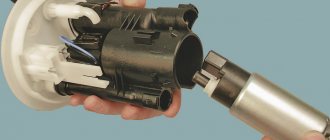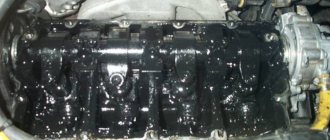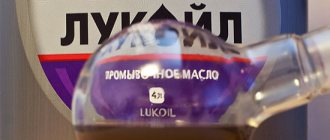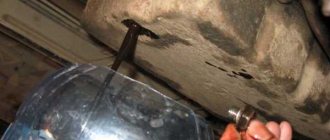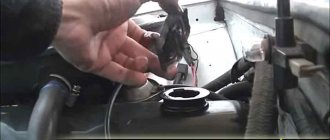Many car owners on forums ask the question: “Why does the engine oil smell like gasoline?” For most people, the smell belongs to the subjective category of sensations: for some it smells slightly like gasoline, for others it smells strongly. The perception of odor intensity is individual for everyone, and only specialists with the necessary equipment can make an objective assessment.
But the fact that the engine oil smelled like gasoline should not be ignored either. Fuel getting into the oil is only possible if there is a malfunction and can lead, at a minimum, to excessive consumption of fuel and oil and, at a maximum, to engine failure.
Symptoms of gasoline in motor oil
In addition to the direct appearance of the smell of gasoline in the engine oil, there are several other signs that there is a certain amount of fuel in the lubricating fluid. In particular:
- The oil level has risen and smells like gasoline. In this case, the oil usually becomes very liquid. This can be felt simply by touch if you try the oil from the dipstick with your fingers. This is especially true for viscous oils, for example, with a viscosity of 10W-40.
- Increased fuel consumption. Usually the increase is small, but in the urban driving cycle it is noticeable.
- Reduced oil pressure. This can be seen from the readings of the corresponding indicator on the car’s dashboard. The pressure decreases due to a decrease in oil viscosity.
- “Floating” engine speed at idle.
- Reduced power and dynamic characteristics of the machine. That is, it accelerates poorly and does not pull.
- It is possible that errors may form in the ECU memory associated with engine sensors.
The first thing to do if you smell gasoline from the oil filler neck or dipstick is to check the control unit for errors using electronic scanners. Moreover, it is advisable not just to find out what errors there are in memory, but to look at the specific parameters being issued.
Why does oil smell like gasoline?
There are eight main reasons why your dipstick smells like gasoline. In particular:
- Poor quality fuel. Gasoline or similar “homemade” liquids often contain chemical compounds that destroy rubber seals. As a result of using this, rubber seals are destroyed and the smell of gasoline may appear in the engine.
- Use of fuel additives. The situation is similar. Many of them destroy sealing gaskets, and accordingly, fuel enters the engine oil, which causes the above-mentioned malfunctions.
- Faulty injectors. In particular, the injectors of injection engines may, over time, allow a certain amount of fuel to pass into the combustion chamber when turned off. This is especially true for cars equipped with engines with direct fuel injection, but it also occurs with conventional injection engines.
- Failure of the fuel vacuum regulator. If it partially fails, a small part of the gasoline returns to the combustion chamber, from where it enters the engine crankcase.
- Rich air-fuel mixture. A mixture that is too rich can be caused by a variety of reasons. However, in any case, gasoline in such a mixture does not burn completely; its residues condense on the cylinder walls, and from there they enter the crankcase, mixing with the engine oil.
- Faulty ignition system components. It could be a coil, a spark plug, or simply damage to high-voltage wires. In any case, if one or more of the mentioned parts is damaged, there will be no spark in a certain cylinder, and accordingly, the air-fuel mixture in it will not burn. As a result, gasoline condenses on the walls and flows into the crankcase.
- Ring wear. This is the most common reason why engine oil smells like gasoline. Wear occurs due to natural causes.
- Weak compression. When the elements of the cylinder-piston group wear out, compression decreases, and as a result, gasoline gets into the crankcase with engine oil.
However, the smell of gasoline in the engine is often found in cars equipped with carburetor engines. The reasons for them usually lie in incorrect carburetor settings (the unit produces a rich air-fuel mixture), or damage to the diaphragm or needle valve. In this case, gasoline will enter the engine and mix there with the engine oil.
Injection nozzles
In an engine with injectors, the smell of gasoline coming from the dipstick indicates a breakdown of the injectors and ignition system. In the first case, we are talking about the fact that the injectors lose proper tightness. After turning off the engine, fuel, due to residual pressure, seeps into the manifold and from there penetrates the cylinder block. The piston rings serve as a barrier to the crankcase, but if they are worn out, gasoline will still get there.
There is also a smell of gasoline if the ignition system is faulty. If a spark plug breaks, the fuel does not ignite in the cylinder block, that is, it is simply wasted. To fix the problem, you need to remove the fuel rail and check the tightness of all injectors one by one by supplying them with kerosene under pressure. Leaking parts and broken spark plugs need to be replaced with new ones.
How to check for gasoline in motor oil
The smell of gasoline from the dipstick or from the neck may not be so strong, and the thinness and decrease in viscosity may not be clearly expressed, especially when it is already low-viscosity. Therefore, it is advisable to perform additional diagnostics, the purpose of which will be to identify the presence of fuel in the lubricant. To do this, they use two methods - a drop test and heating the oil and then igniting the fumes.
In the first case, you just need to apply a small amount of oil on a clean sheet of paper and wait about 12 hours. Further, by the appearance of the resulting stain, one can judge the presence of gasoline, and, accordingly, the smell of the oil.
As for heating, the test oil is placed in a glass test tube, its neck is sealed, and the test tube itself is heated over an open fire or on an electric stove. After this, the cap is removed from the test tube and the gases emanating from the test tube are ignited. If they do not burn, it means that there is no gasoline in the oil or its amount is negligible. If a flame forms at the neck of the test tube, it means there is gasoline in the oil.
Signs of a Leak
Is it possible to understand that there is a leak? You can find out about this by noticing a dark puddle under the car. It happens that lubricant leaks from under the valve cover lining, oil seals or crankcase gasket. Motor oil can only be mixed with fuel in the engine. It is possible to determine that gasoline has entered the oil liquid by the following signs:
- the viscosity of the oil changed, it became thinner;
- the car oil on the dipstick lights up if you bring the flame close to it;
- A drop of oil on a piece of paper leaves a greasy, growing stain.
Consequences of using oil with gasoline
It is possible to operate a car whose engine oil contains a significant admixture of gasoline, but not for long. The fact is that fuel in oil is harmful for two reasons. First, it reduces viscosity. Accordingly, the oil becomes more liquid and loses its lubricating properties. This is especially true for viscous oils used in southern (hot) regions and/or on worn engines.
The second harmful factor is that gasoline neutralizes the effect of the additives that make up the motor oil. In particular, anti-corrosion, lubricating, restoring, and extending the service life of engine parts. All this leads to a decrease in the overall engine life. Accordingly, if the smell of gasoline in the oil is detected, it is necessary to carry out diagnostics as early as possible and carry out appropriate repair measures.
Poor quality fuel
Sometimes the cause of incomplete combustion of the fuel mixture in the cylinders is the gasoline itself. It is not uncommon that the quality of fuel at gas stations leaves much to be desired. Moreover, gasoline may be mixed with other additives that make it more difficult to ignite. Unburned fuel mixture residues penetrate into the engine crankcase. In these cases, to fix the problem, you need to start using another gas station, but you will still have to change the oil.
Some experts advise, as a preventative measure, when driving on open roads, to allow the engine to run for a short time at high speeds. This type of driving leads to higher oil temperatures. This reduces the amount of condensate accumulated in the lubricant and gasoline entering the oil.
What to do if the oil smells like gasoline
The implementation of repair and preventive measures depends on the reason for the smell of gasoline in the oil. We list them in the same order as the reasons:
- Use high-quality gasoline and refuse to use fuel additives, since they actually do more harm than good. In addition, it is necessary to check the rubber and hoses in the fuel and oil system of the car. If damaged elements are identified, they should be replaced with new ones.
- Check fuel injectors. The check can be performed in a garage or even at home, after first removing them from the engine. If the injector is leaking fuel, there may be a problem with its winding. In most cases, in this case, the nozzle is replaced with a new one.
- If the fuel regulator fails, it also needs to be replaced.
- Rich air-fuel mixture. In this case, you need to check the operation of the engine sensors, read the existing errors from the ECU memory (if any), in general, find out why the mixture is too rich, and accordingly, eliminate the cause.
- Faulty ignition elements. You need to check the operation of the spark plugs, coils and the integrity of the wires. The spark plugs can be cleaned, but the coils and wires usually cannot be repaired, and if they fail, they must be replaced with new units.
- Ring wear. This happens for natural reasons, so replacement is also necessary.
- Weak compression. You need to perform an engine compression check. If in one or more cylinders its value does not meet the technical requirements, it is necessary to carry out appropriate repair measures, often this means a major overhaul of the engine.
After troubleshooting your car's engine, don't forget to replace the engine oil and oil filter with new ones. However, before replacement, it is advisable to wash the engine oil system using special products.
Malfunctions and checking of injectors of the injection power system
If one or more injectors do not close completely, fuel may leak into the cylinder and through the piston clearances into the oil. First, you can check the pressure in the power system. To do this, you need to get a pressure gauge with a rubber hose for high pressure and an adapter for connecting to the fuel rail. The upper limit of the pressure measured by the pressure gauge must be at least 6 kgf/cm².
The adapter must be connected to the ramp, the pressure gauge must be connected to the adapter. Then you need to turn on the ignition. If the fuel pump starts, wait until normal pressure rises in the rail. Then turn off the ignition. If the fuel pump does not start when the ignition is turned on (this is not a malfunction), start the engine, check that the pressure rises to the nominal value, turn off the engine and turn off the ignition.
We recommend: Signs of a faulty fuel pressure regulator
You need to observe the pressure gauge readings for 5-10 minutes. If the instrument needle has moved downward by more than a third (example: the nominal pressure was 3 kgf/cm², after stopping it dropped to 2 kgf/cm²), you should look for a leak in the fuel supply system. Next, you need to remove the fuel rail with injectors and place it in a place accessible for inspection.
Injectors that are not completely closed can cause fuel to enter the lubricant.
Each of the nozzles should be placed in a transparent container; you can use plastic glasses with a volume of 0.5 liters. Fuel lines and electrical connections must be connected. Then you also need to turn on the ignition and, if necessary, crank the engine with the starter.
While scrolling, you can visually check the operation of the injectors by the type of fuel being sprayed. Having reached the optimal pressure in the power system, you need to turn off the ignition and visually check each of the injectors for gasoline leakage through the nozzle. If you detect leakage on one or more injectors, you can measure the resistance of the windings with a tester.
If the measured resistance value differs from the nominal value (usually 10-15 Ohms), the injector is leaking, or the spray pattern is different from others, then the injector must be replaced in accordance with the vehicle manual. After completing the repair, it is also necessary to check the oil for a certain period of operation.



